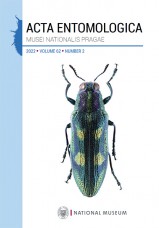Taxonomic revision of Montina (Hemiptera: Heteroptera: Reduviidae) from Colombia with description of three new species
Mejía-Soto Andrés, Forero Dimitri, Wolff Marta
Acta Entomologica Musei Nationalis Pragae 62(2): 325-381, 2022
Published online: 16th December 2022
Views: 1496
Abstract: The Neotropical assassin bug genus Montina Amyot & Serville, 1843
(Reduviidae: Harpactorinae) is revised for Colombia. Montina has not been
adequately explored taxonomically, with its last described species published in
1867. It has ten valid species distributed in tropical areas of Central and
South America, but none of them have been formally recorded from Colombia. We
describe three new species, M. calarca Mejía-Soto & Forero sp. nov., M.
gladiator Mejía-Soto & Forero sp. nov., M. tikuna Mejía-Soto & Forero
sp. nov., and report seven species as new records for the country: M. confusa
(Stål, 1859), M. distincta (Stål, 1859), M. fumosa (Stål, 1867), M. lobata
Stål, 1859, M. ruficornis (Fabricius, 1803), M. scutellaris Stål, 1859, and M.
testacea (Stål, 1859). Montina calarca sp. nov. is distinguished by the reddish
coloration with black head and legs; densely setose pronotum; connexival margin
rounded on segments 4, 5, and 6 without protuberances, connexivum black with a
narrow red band on margin; and translucent yellow membrane with hyaline cells
and darkened veins. Montina gladiator sp. nov. is distinguished by the red
coloration, with black legs, scutellum, and abdomen; connexival margin 4–5
lobed, 6 straight, segments 2–4 with acute posterior process on each segment,
connexivum dark brown to black with a narrow red band on its margin. Montina
tikuna sp. nov. is distinguished by the reddish-brown coloration, with black
scutellum and abdomen; connexival margin nearly straight, segments 2–4 with
small posterior acute process, 5–6 with obtuse process, connexivum black;
ventral laterotergites only with black scattered erect setae. New characters
help delimit Montina and differentiate it from Ploeogaster Amyot & Serville,
1843, its most similar genus. For all species we provide a diagnosis, images,
documentation of genitalia, and distribution maps. A key to all the species of
Montina is provided.
Key words: Hemiptera, Heteroptera, Reduviidae, Harpactorini, genitalia, new record, species discovery, Colombia, Neotropical Region, South America
Papers
This issue is dedicated to the memory of Svatopluk Bílý (1945–2022)The true identity of Periscelis winnertzii and description of P. laszloi sp. nov. from Europe (Diptera: Periscelididae)Taxonomic revision of Montina (Hemiptera: Heteroptera: Reduviidae) from Colombia with description of three new speciesPlatyplastinx ibanezbernali sp. nov., a new species of moth fly (Diptera: Psychodidae) from EcuadorERRATUM: Platyplastinx ibanezbernali sp. nov., a new species of moth fl y (Diptera: Psychodidae) from Ecuador. Acta Entomologica Musei Nationalis Pragae 62 (2): 383–389. https://doi. org/10.37520/aemnp.2022.020New data on the early stages and behaviour of the endangered species Callophrys mystaphia (Lepidoptera: Lycaenidae) and its first larval parasitoid, Cotesia sp. (Hymenoptera: Braconidae)Megacraspedus (Lepidoptera: Gelechiidae) of the Altai Mountains with description of a new species belonging to the M. majorella groupPhylogeny, diversity and biogeography of flightless amphi-Pacific lymantine weevils (Coleoptera: Curculionidae: Molytinae)The Oleaceae-feeding lace bugs of the genus Perissonemia from Japan (Hemiptera: Heteroptera: Tingidae)Description of a new species of the genus Chrysolina (Coleoptera: Chrysomelidae) from Honshu, and notes on records of Chrysolina aeruginosa in JapanHeteroptera (Hemiptera) of the Socotra Archipelago I: Introduction, Nepomorpha, Gerromorpha and LeptopodomorphaCatalogue of type specimens of braconid wasps (Hymenoptera: Braconidae) deposited in the National Museum, Prague, Czech Republic 